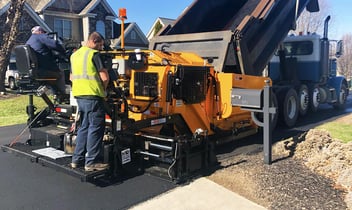How to make a truck preventive maintenance schedule
Fleet managers have to know their equipment like the back of their hand. You need to be crystal clear on what you have and where it’s located, along with the working condition of each piece of equipment. It’s a tall order to effectively manage this scope of responsibility—especially when it comes to ensuring each vehicle in your fleet is properly, proactively maintained.
A preventive maintenance schedule helps ensure your equipment is always regularly serviced so you can not only keep your fleet in top working condition, but get ahead of any problems before they start.
This post will help you demonstrate the impact of a preventive maintenance schedule for your trucks and your business and bring you up to speed on how to create your own.
What is Preventive Maintenance?
Preventive maintenance is a system of scheduled maintenance activities designed to prolong the lifespan of company vehicles through regular inspection. This maintenance type proactively identifies and corrects potential problems before they become larger and more costly.
This type of truck maintenance goes beyond pre-trip inspection checklists and takes a big-picture approach to vehicle and fleet management. Common examples of preventive tasks include oil changes, checking spark plugs, and inspecting hoses; but a robust program covers much more than that. Owner’s manuals provide a great starting point for specific vehicle requirements, in addition to the basics that should be on every heavy equipment maintenance checklist.
Benefits of Preventive Maintenance
Properly maintained vehicles are the backbone of any profitable fleet. Frequent and routine maintenance leads to fewer mechanical problems saving time, money, and headaches. But the upside of a proactive truck maintenance plan doesn’t stop there. Here are some key benefits a solid plan will create:
Less unexpected downtime
Scheduling regular and planned intervals to inspect and keep critical equipment working in top condition means less unexpected downtime due to equipment failure. By getting ahead of issues before they compromise vehicle performance, you can keep your trucks on the road making money. With costs of doing business continuously rising, it’s more important than ever to minimize unexpected downtime and keep drivers moving.
Improved fuel economy
Well-maintained vehicles assist with good engine performance and contribute to improved fuel economy and lower cost of ownership. Simple preventive activities like keeping tires at proper inflation and oil filters fresh add up to cause a noticeable impact to performance and costs overtime.
Improve safety
Catching potential issues before they happen is the name of the game in preventive maintenance. Regular maintenance checks, such as ensuring brakes and bearings are in proper working condition, also help avoid mechanical failures that pose safety risks to drivers and others on the road and on job sites.
Reduce repair costs
The cost of repairing and maintaining equipment can be staggering for a company’s bottom line, and preventive maintenance is one way organizations can control or reduce those costs. Reactive or unplanned maintenance can include a lot of lost time responding to emergencies, diagnosing equipment, or waiting for parts, not to mention lost driver time. The goal of preventive maintenance is to reduce these costs by increasing efficiency and reducing costs through regular scheduled maintenance.
Improve company reputation
Whenever your truck is unexpectedly out of commission due to unplanned repairs, someone is left in the lurch. When this becomes a pattern, trust in your company begins to dwindle. By ensuring your fleet is always in prime working condition, you can avoid letting your clients, staff, and other stakeholders down. Preventive maintenance can help build your reputation as reliable, prepared, and polished.
Increase truck lifespan
Consistently maintaining trucks and avoiding major damage or excessive wear and tear is the primary way to prolong the life of any vehicle. Preventive maintenance is a method of protecting the investment you’ve made in your fleet trucks and getting the most out of it. It’s far less costly to keep a truck well-maintained than to replace it every few years. And with consistent care, you can keep your fleet looking as great as it performs, too.
What regular maintenance should be done on a truck?
Regular truck maintenance should be completed on scheduled intervals. While manufacturer specifications, seasonality, and usage may dictate the cadence of the intervals and what is included in each check, make sure to consider the following areas:
- All engine oil, filters, and transmission fluid levels
- Oil pressure
- Cooling and heating systems
- All mounts, drive shafts, CV joints, belts, and hoses
- Engine tune up
- Electrical systems and components
- Braking system
- Fuel system
- Tires, wheels, rims, undercarriage, and frame
- Steering and suspension system
- Exhaust system
- Auxiliary vehicle systems
- Body, glass, mirrors, seat belts, seat structure
- Exterior and interior lights
Daily trip checks
Because managing a fleet requires expertly orchestrating many moving parts every day, to keep equipment issues and costs at bay preventive maintenance considerations should be part of daily operations
On a day-to-day basis, truck drivers are responsible for completing pre-trip inspections to ensure that vehicles are in safe and proper operating condition every time they take it on the road. These daily vehicle inspections cover a number of items that should be checked and inspected regularly like tires, fluids, electrical systems, and brakes. Problems that may lead to issues like brake failure and tire blowouts can easily be addressed by pre-trip inspection checklists.
Seasonal truck maintenance
During the summer and winter months weather changes offer particular challenges for commercial vehicles. The following table offers some items to consider, based on the season or time of year:

During the summer, when the weather is usually hot and dry, maintenance focuses more on the cooling system since it will be working extra hard during that time. Additionally, expanding hot air can cause changes in tire pressure so this is also an area of special interest in those hot months; tires should be checked weekly.
Winter weather brings its own set of challenges and maintenance should focus on the parts of the vehicle that can be affected by extremely cold weather, snow, and ice. For diesel engines, taking extra precautions in the winter can extend the life of different components and systems. Winter maintenance practices should also include stocking rigs with essential safety parts and gear, given the possibility of extreme driving conditions.
Preventive maintenance by mileage
Maintenance planning can be time-based or usage-based in addition to seasonal. Individual fleet vehicles and their usage patterns will largely determine the frequency and schedule of preventive maintenance tasks.
The following table gives a general outline of recommended maintenance intervals for commercial trucks, based on normal, heavy duty use above and beyond what pre-trip checks might cover.

Source: State of Utah Department of Administrative Services – Division of Fleet Operation
How to design a preventive maintenance program
Keeping a truck fleet properly maintained is no small task. There is a long list of maintenance items and many ways to potentially plan preventive intervals.
The only way to effectively ensure that your fleet is always well-maintained is to develop a systemized schedule for your fleet maintenance. No single maintenance schedule will work for every fleet or every truck, but by following these steps you can build a program that is best suited for your company:
1. Establish a baseline
Before you begin, it’s important to take stock of your fleet. Every vehicle is different and you’ll want to assess the needs of each truck and review the manufacturer’s specifications. Take stock of all maintenance records for each vehicle and ensure that these records are accurate, accessible, and up to date.
This practice helps triage each truck’s preventive maintenance needs, ensures that your fleet is compliant with safety regulations, and sets a healthy foundation for your maintenance plan.
2. Develop a plan for each vehicle
Once you know what your fleet vehicles’ individual requirements are, you can start to develop and plan a schedule for each vehicle. Especially where trucks will be used in different ways, the preventive maintenance needs will differ greatly.
As discussed, a preventive maintenance schedule can be based on a number of factors including uses, seasons, and metrics such as time, mileage, or engine hours. Monitoring these indicators helps you prepare for when each truck will need to be serviced next.
3. Train staff
When it comes to truck maintenance, it all begins with the driver. They are a key participant in any preventive maintenance program. Since truck operators are responsible for pre-trip inspections, they are actively monitoring several vehicle systems already.
Equip drivers and other staff with the proper knowledge to perform inspections and consider creating checklists or other documentation to assist in the process. Proper training not only shows employees how to perform the inspections or maintenance, but also how to document and record their findings.
4. Record and document
From a pre-service checklist to a maintenance checklist, effective truck maintenance requires record keeping. Keeping records of what needs to be done and when is key to not only managing the schedule, but staying compliant as well.
Developing a method to collect and report on maintenance information, such as with the help of software, is essential to a successful preventive plan. When considering options, remember that paper documentation runs the risk of getting lost, destroyed, or stolen.
Getting started with a preventive maintenance plan for your trucks
Vehicle maintenance plays an important role in your business and preventive maintenance can not only protect your investments, but have a real impact on your bottom line.
Unexpected breakdowns or repairs can drive costs and result in lost productivity, not to mention reduce a truck’s overall lifespan. When fleet costs can run well into the millions, taking a proactive approach to maintenance can help keep those costs down and keep your trucks moving.
Truck fleet management software
Tread.io is a fleet management software that collects valuable fleet and driver data, which can assist you with preventive maintenance scheduling, dispatching, and truck management. Tread accurately records operating hours and usage so equipment maintenance can be better managed and scheduled. With no hardware installation required, data can be accessed from a desktop, tablet, or smartphone any time.
Request a demo today to learn how Tread can be part of your truck preventive maintenance strategy.
Read On

Construction Equipment Maintenance: Why It Matters
Owning and operating a construction company is not without its challenges, the biggest of which is...

Ultimate heavy equipment maintenance checklist
For any construction company to be profitable, their heavy machinery must be well maintained and in...

Construction fleet management key performance indicators
Tracking Key Performance Indicators is important to understand a business’s health and performance....

